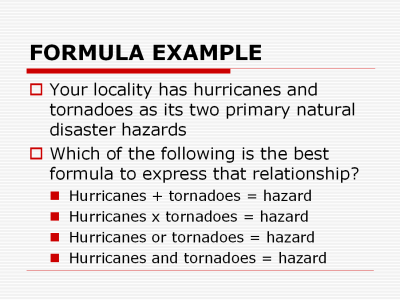| front |1 |2 |3 |4 |5 |6 |7 |8 |9 |10 |11 |12 |13 |14 |15 |16 |17 |18 |19 |20 |21 |22 |23 |24 |review |
 |
If
tornadoes can occur during a tropical cyclone, is the maximum hazard
intensity the intensity of
the probable hurricane plus the intensity of the
probable tornado (typically these are weak Fujita F1 events)?
Given a Category 2 hurricane and a F1 tornado, is the result
either a F3 tornado or a Category 3 hurricane?
Or would we add the two windspeeds, 110 miles per hour for the
tornado and 100 miles per hour for the hurricane equals 210 miles per
hour windspeed (a category 6 or greater hurricane in an expanded
Saffir-Simpson Scale)?
Or is multiplicative? Does a Category 2 hurricane with an unusually strong embedded Fujita F2 tornado become a Category 4 hurricane (C2 x F2 = H4)? Do F2 winds at 150 miles per hour multiply by the Category 2 winds of 100 miles per hour to create a 15,000 mile per hour wind storm … clearly not. The answer to both of these quasi-mathematical approaches is no, because the tornadoes are isolated and transient events in a much bigger storm. And you cannot multiply (Category 2 x F2) or add (Category 2 + F1) . These are nominal data – the 2s in Category 2 and F2 are names, not numerical values.Finally, are hurricanes and tornadoes are exclusive events always with different seasons or are they always related events? In this case we have tornadoes that are related to tropical cyclones, but not every tropical cyclone has embedded tornadoes. And tornadoes can occur in the absence of tropical cyclones. |